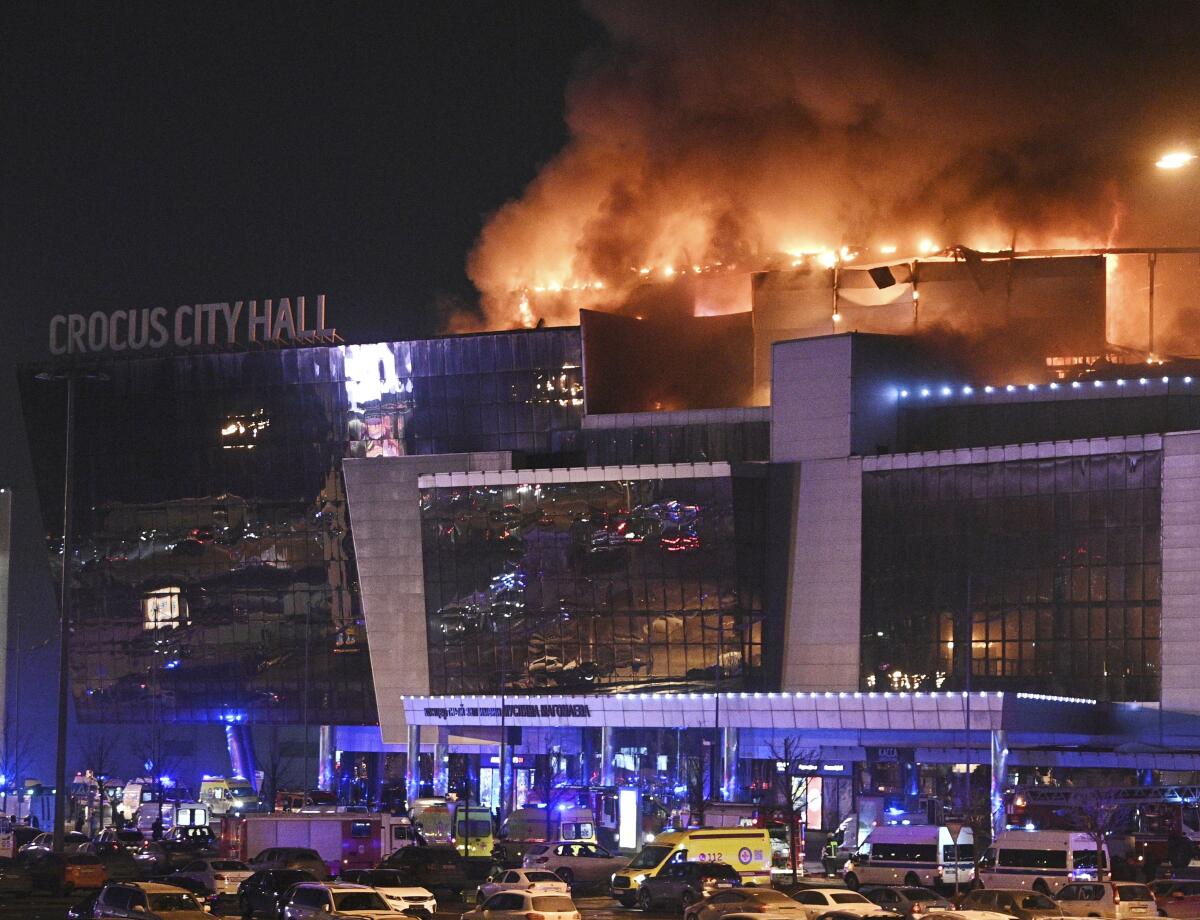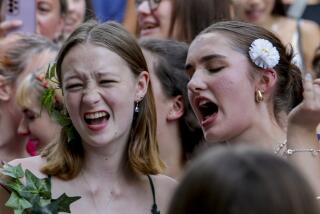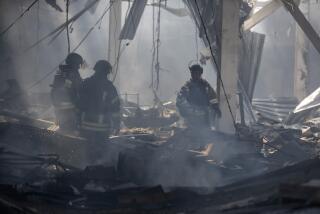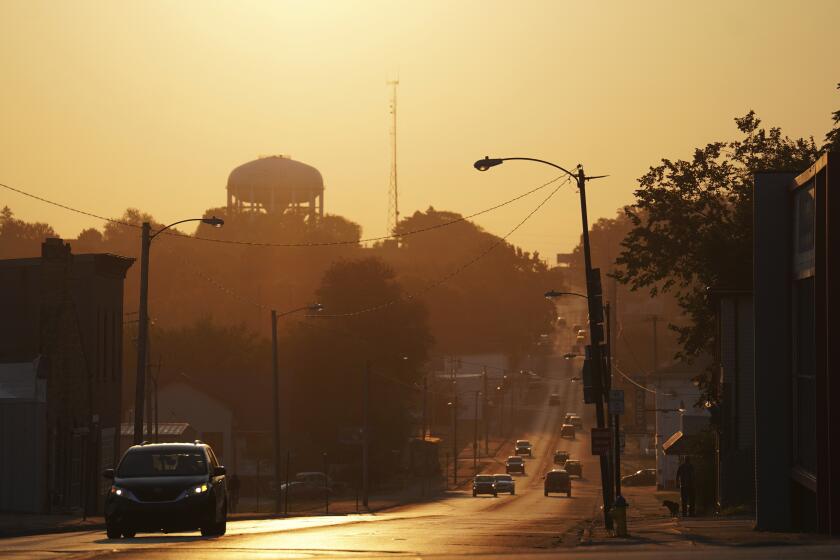Russia says 93 killed, 11 detained in Moscow concert hall attack

MOSCOW — Russian officials say 93 people have been killed by assailants who burst into a concert hall in western Moscow and sprayed the crowd with gunfire. The Islamic State group claimed responsibility for the attack in a statement posted on affiliated channels on social media.
The attack was the deadliest in Russia in years and left the concert hall in flames and with a collapsing roof. The head of Russia’s Federal Security Service told President Vladimir Putin on Saturday that four people directly involved in the attack were among 11 people detained, Russian state news agency Tass said.
At least three children were among those killed in the Friday assault, Russian authorities said Saturday.
Images shared by Russian state media Saturday showed a fleet of emergency vehicles still gathered outside the ruins of Crocus City Hall, a shopping mall and music venue with a capacity of more than 6,000 people in Krasnogorsk, on Moscow’s western edge.
Friday’s attack came just days after Putin cemented his grip on power in a highly orchestrated electoral landslide and as the country’s fight in Ukraine dragged into a third year.
Videos posted online showed gunmen in the venue shooting civilians at point-blank range. The roof of the theater, where crowds had gathered Friday for a performance by the Russian rock band Piknik, collapsed in the early hours of Saturday morning as firefighters spent hours fighting a fire which erupted during the attack.
The Islamic State militant group claimed responsibility for the attack in a statement posted on affiliated channels on social media. A U.S. intelligence official told the Associated Press that American spy agencies had learned that the group’s branch in Afghanistan was planning an attack in Moscow and shared the information with Russian officials.
Video aired Friday night showed the building on fire, with a huge cloud of smoke rising through the night sky. The street was illuminated by the blinking blue lights of dozens of firetrucks, ambulances and other emergency vehicles as fire helicopters buzzed overhead to dump water on the blaze that took hours to contain.
The prosecutor’s office said several men in combat fatigues entered the concert hall and fired on concertgoers.
Dave Primov, who was in the hall during the attack, described panic and chaos when the attack began.
“There were volleys of gunfire,” Primov told the AP. “We all got up and tried to move toward the aisles. People began to panic, started to run and collided with each other. Some fell down and others trampled on them.”
One video posted by Russian media showed a man in the auditorium saying the assailants had set it on fire, as gunshots were heard incessantly.
Guards at the concert hall didn’t have guns, and some could have been killed at the start of the attack, Russian media reported. Some Russian news outlets suggested the assailants fled before special forces and riot police arrived. Reports said police patrols were looking for several vehicles the attackers could have used to escape.
In a statement posted by its Aamaq news agency, Islamic State said it attacked a large gathering of “Christians” in Krasnogorsk, killing and wounding hundreds. It was not immediately possible to verify the authenticity of the claim.
But U.S. intelligence officials confirmed the claim by Islamic State’s branch based in Afghanistan that it was responsible for the attack, a U.S. official told the AP.
The official said U.S. intelligence agencies had gathered information in recent weeks that the Islamic State branch was planning an attack in Moscow. He said U.S. officials privately shared the intelligence this month with Russian officials. The official was briefed on the matter but was not authorized to publicly discuss the intelligence information and spoke to the AP on condition of anonymity.
Noting that the Islamic State statement cast its claim as an attack targeting Christians, Aymenn Jawad al-Tamimi, an expert on the terrorist group, said it appeared to reflect the group’s strategy of “striking wherever they can as part of a global ‘fight the infidels and apostates everywhere.’”
In October 2015, a bomb planted by Islamic State downed a Russian passenger plane over the Sinai Peninsula, killing all 224 people on board, most of them Russian vacation-goers returning from Egypt. The group, which operates mainly in Syria and Iraq but also in Afghanistan and Africa, also has claimed several attacks in Russia’s volatile Caucasus and other regions in years past. It recruited fighters from Russia and other parts of the former Soviet Union.
On March 7, Russia’s top security agency said it thwarted an attack on a synagogue in Moscow by an Islamic State cell, killing several of its members in the Kaluga region near the Russian capital. A few days earlier, Russian authorities said six alleged Islamic State members were killed in a shootout in Ingushetia in Russia’s Caucasus region.
On Friday, statements of outrage, shock and support for those affected by the concert hall attack streamed in from around the world.
Some commentators on Russian social media questioned how authorities, who relentlessly surveil and pressure Kremlin critics, failed to identify the threat and prevent the attack.
Russian officials said security was tightened at Moscow’s airports, railway stations and the capital’s sprawling subway system. Moscow’s mayor canceled all mass gatherings, and theaters and museums closed for the weekend. Other Russian regions also tightened security.
The Kremlin didn’t immediately blame anyone for the attack, but, before Islamic State claimed responsibility, some Russian lawmakers were quick to accuse Ukraine and called for ramping up strikes. Hours before the attack, the Russian military launched a barrage on Ukraine’s power system, crippling the country’s biggest hydroelectric plant and other energy facilities and leaving more than a million people without electricity.
Dmitry Medvedev, deputy head of Russia’s Security Council, said that if Ukrainian involvement was proved, all those involved “must be tracked down and killed without mercy, including officials of the state that committed such outrage.”
Mykhailo Podolyak, an advisor to Ukrainian President Volodymyr Zelensky, denied Ukrainian involvement.
“Ukraine has never resorted to the use of terrorist methods,” he posted on X. “Everything in this war will be decided only on the battlefield.”
John F. Kirby, spokesman for the White House National Security Council, said he couldn’t yet speak about the details but “the images are just horrible. And just hard to watch.”
Friday’s attack followed a statement this month by the U.S. Embassy in Moscow that urged Americans to avoid crowded places in view of “imminent” plans by extremists to target large gatherings in the Russian capital, including concerts. The warning was repeated by several other Western embassies.
National Security Council spokesperson Adrienne Watson said Friday the U.S. government had information about a planned attack in Moscow, prompting the State Department advisory to Americans. The U.S. government shared the information with Russian authorities in accordance with its long-standing “duty to warn” policy, Watson said.
Putin, who extended his grip on Russia for another six years in last weekend’s presidential vote after a sweeping crackdown on dissent, denounced the Western warnings as an attempt to intimidate Russians. “All that resembles open blackmail and an attempt to frighten and destabilize our society,” he said this week.
Russia was shaken by a series of deadly terrorist attacks in the early 2000s during the fighting with separatists in the Russian province of Chechnya.
In October 2002, Chechen militants took about 800 people hostage at a Moscow theater. Two days later, Russian special forces stormed the building and 129 hostages and 41 Chechen fighters died, most from effects of narcotic gas Russian forces used to subdue the attackers.
In September 2004, about 30 Chechen militants seized a school in Beslan in southern Russia, taking hundreds of hostages. The siege ended in a bloodbath two days later, and more than 330 people, about half of them children, were killed.
More to Read
Sign up for Essential California
The most important California stories and recommendations in your inbox every morning.
You may occasionally receive promotional content from the Los Angeles Times.










